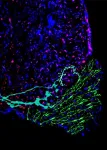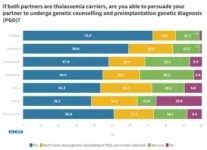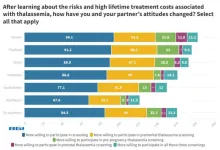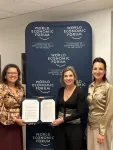(Press-News.org)
Unlike humans, zebrafish can completely regenerate their hearts after injury. They owe this ability to the interaction between their nervous and immune systems, as researchers led by Suphansa Sawamiphak from the Max Delbrück Center now report in the journal Developmental Cell.
Each year, more than 300,000 people in Germany have a myocardial infarction – the technical term for heart attack. The number of people surviving a heart attack has increased significantly, but this severe cardiac event causes irreparable damage to their hearts. A heart attack occurs when blood vessels that supply blood and oxygen to the heart muscle become blocked, causing part of the heart muscle tissue to die. This damage is permanent because the human heart has no ability to grow new heart muscle cells. Instead, connective tissue cells known as fibroblasts migrate into the damaged area of the heart muscle. They form scar tissue that weakens the pumping power of the heart. Previous attempts to use stem cells to treat infarction-damaged hearts have not been very successful.
The team led by Dr. Suphansa Sawamiphak, head of the Cardiovascular-Hematopoietic Interaction Lab at the Max Delbrück Center, is looking at the process from a different angle. “We know that both signals from the autonomic nervous system and the immune system play a pivotal role in scarring and regeneration,” says Sawamiphak. “So it stands to reason that the communication between the autonomic nervous and immune systems determines whether heart muscle scarring will occur or whether the heart muscle can recover.” It is also known that macrophages play a role in both processes. But how is this decision made?
To address this question, the researchers are studying zebrafish larvae. The fish can be easily modified and are also optically transparent, making internal processes easy to observe in the living organism. “Plus, they can fully regenerate their heart after an injury,” says Onur Apaydin, first author of the study published in “Developmental Cell.”
Signaling for regeneration
The researchers used zebrafish larvae whose heart muscle cells produce a fluorescent substance, making it easy to detect them under a microscope. They then induced an injury similar to a myocardial infarction in the larval hearts and blocked several receptors on the surface of the macrophages. The result was that adrenergic signals from the autonomic nervous system determined whether the macrophages multiplied and migrated into the damaged site. These signals also played an important role in regenerating heart muscle tissue.
In the next step, the researchers engineered genetically modified zebrafish in which the adrenergic signal reached the macrophages but could not be transmitted from the receptor into the cell’s interior. “This showed that signal transmission is crucial for heart regeneration,” says Apaydin. If signaling is interrupted, the scarring process is triggered instead.
“Our findings indicate that this is a key regulator of crosstalk between the nervous and immune systems,” says Apaydin. When macrophages are activated by the adrenergic signals of the autonomic nervous system, they in turn communicate with fibroblasts. Fibroblasts that promote regeneration alter the extracellular matrix at the damaged site. This ultimately creates a microenvironment conducive to the growth of blood and lymph vessels and to the development of new heart vessels. If, on the other hand, the signal is blocked, fibroblasts infiltrate the site and cause scarring – similar to what occurs in the human heart after a heart attack.
“We next want to examine in detail how signaling differs between zebrafish and humans,” says Sawamiphak. “This will help us understand why heart muscle tissue is unable to regenerate in humans.” The team also hopes to identify potential targets for influencing the interaction between the nervous and immune systems in a way that promotes the regeneration of heart muscle tissue and the maintenance of heart function in heart attack patients.
Further information
Sawamiphak Lab
Heart muscle cells merge when the heart grows and repairs itself
Max Delbrück Center
The Max Delbrück Center for Molecular Medicine in the Helmholtz Association (Max Delbrück Center) is one of the world’s leading biomedical research institutions. Max Delbrück, a Berlin native, was a Nobel laureate and one of the founders of molecular biology. At the locations in Berlin-Buch and Mitte, researchers from some 70 countries study human biology – investigating the foundations of life from its most elementary building blocks to systems-wide mechanisms. By understanding what regulates or disrupts the dynamic equilibrium of a cell, an organ, or the entire body, we can prevent diseases, diagnose them earlier, and stop their progression with tailored therapies. Patients should be able to benefit as soon as possible from basic research discoveries. This is why the Max Delbrück Center supports spin-off creation and participates in collaborative networks. It works in close partnership with Charité – Universitätsmedizin Berlin in the jointly-run Experimental and Clinical Research Center (ECRC), the Berlin Institute of Health (BIH) at Charité, and the German Center for Cardiovascular Research (DZHK). Founded in 1992, the Max Delbrück Center today employs 1,800 people and is 90 percent funded by the German federal government and 10 percent by the State of Berlin. www.mdc-berlin.de
END
(Boston)—CITE-seq (cellular indexing of transcriptomes and epitopes) is an RNA sequencing-based method that simultaneously quantifies cell surface protein and transcriptomic data within a single cell readout. The ability to study cells concurrently offers unprecedented insights into new cell types, disease states or other conditions.
While CITE-seq solves the problem of detecting a limited number of proteins while using single-cell sequencing in an unbiased way, one of its limitations is the high levels of background noise that can hinder analysis.
To rectify ...
5.2% of the global population carry hemoglobin abnormalities, resulting in 300,000 to 400,000 children born with severe hemoglobinopathies annually. Thalassemia, a hereditary hemoglobinopathy, occurs in 4.4 out of every 10,000 live births, and is prevalent in Mediterranean coastal areas, Africa, the Middle East, Southeast Asia, and southern China.
To facilitate greater understanding of thalassemia, a hereditary hemoglobinopathy, BGI Genomics today released its State of Thalassemia Awareness Report. This report assesses the level of knowledge and attitudes related to the associated health risks, thalassemia carrier ...
The Alliance Bioversity International and CIAT signed an agreement with the World Economic Forum that enables the Alliance to manage initiatives under the Food Action Alliance, a movement led by the World Economic Forum for transforming sustainable food systems.
The Alliance would establish and manage initiatives in Latin America, the Caribbean, and other regions under the Food Action Alliance to boost the transformation of food systems, facilitating and scaling up multi-stakeholder flagship initiatives in specific countries mostly with multi-national companies such as Bayer, Microsoft, PepsiCo, AB InBev; among others.
The Food Action Alliance will continue to grow initiatives ...
WASHINGTON, November 17, 2023 – The U.S. Department of Agriculture (USDA) released today the National Strategic Germplasm and Cultivar Collection Assessment and Utilization Plan in support of the Agricultural Research Service (ARS) U.S. National Plant Germplasm System’s (NPGS) mission.
The USDA-ARS NPGS is confident that implementing this plan will address current operational and research challenges. The collection is vital for maintaining the nation’s food supply by providing breeders and researchers the germplasm they need to furnish U. S. consumers with abundant, ...
Proteins misfolding and clumping together, a process known as aggregation, is a key feature seen in several neurological conditions, including Alzheimer's and Parkinson's diseases.
These disorders involve the formation of small, potentially harmful structures called oligomers, which could serve as valuable indicators for early diagnosis. They are incredibly small, however, and much rarer than the healthy non-aggregated proteins. This makes it hard to detect and measure them accurately.
In collaboration with UCB Biopharma, researchers from the University of Edinburgh’s ...
Researchers in Japan and Mongolia have carried out the world's first instance of incorporating satellite-based CO2 emission estimates into a GHG emission report as the verification on the Second Biennial Update Report (BUR2) of Mongolia submitted to the UNFCCC on 15 November 2023, resulting in high accuracy match with actual reported values, reports a new study published online in Scientific Reports in 2023.
Countries have reported their CO2 emissions to the UNFCCC, primarily from human activities and a significant contributor to climate change. ...
Approximately one-fifth of the world's electric energy is dedicated to refrigeration, and the International Energy Agency anticipates a twofold increase in the number of air conditioning units by 2040. Despite a century of advancements, existing refrigeration systems, relying on vapour compression, have hit their thermodynamic threshold. These systems not only emit greenhouse gases, contributing to environmental issues, but also produce significant noise. Prioritizing the development of energy-efficient and eco-friendly systems is thus paramount to address global warming ...
Growth is a fundamental biological process and a prerequisite for living organisms to develop and reproduce. The processes of cell growth (i.e. the production of new biomass) and of cell division must be coordinated with each other.
In multicellular organisms such as humans, the growth of cells must also be coordinated with their environment so that cells are present in the right number and size to form functional tissue or organs. Cell growth is therefore strictly regulated and takes place only when certain growth signals are present.
But cancer cells are different. They grow unchecked, they divide ...
A research project led by Professor Mingxin Huang at the Department of Mechanical Engineering of the University of Hong Kong (HKU) has made a brand-new breakthrough over conventional stainless steel and the development of stainless steel for hydrogen (SS-H2).
This marks another major achievement by Professor Huang’s team in its ‘Super Steel’ Project, following the development of the anti-COVID-19 stainless steel in 2021, and ultra-strong and ultra-tough Super Steel in 2017 and 2020 respectively.
The new steel developed by the team exhibits high corrosion ...
NYC Media Lab (NYCML) and Bertelsmann unveiled the latest cohort joining the AI & the Creative Industries Challenge, a nine-week program in which teams explore new ways to use artificial intelligence (AI) to create digital content and reach new audiences for three Bertelsmann companies: Fremantle, Penguin Random House, and BMG. The teams are tasked with addressing how AI will impact these important creative industries.
This ongoing partnership, NYCML’s third project with Bertelsmann, will continue to build on new business frontiers enabled by technology. The four selected teams, from around the globe, come from various multidisciplinary ...






